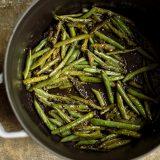The challenge of stir-frying green beans is that, more often than not, the frills slide off and you’re left biting into a bland bean. The key is cooking them in a sauce that has staying power.
Our inspiration came from Vietnam, where savory foods such as fish, chicken and tofu are often simmered in a bittersweet caramel called nuoc mau (pronounced nook mao). The fragrant sauce is a simple blend of sugar and water cooked until it turns a rich coffee-black.
Vietnamese chef Charles Phan does this at his San Francisco restaurant The Slanted Door. He stir-fries blanched string beans in a quick nuoc mau made in the blistering heat of a wok. A final toss in sake and fish sauce coats the charred beans with the dark, viscous caramel.
Though the flavors in Phan’s recipe are easy enough to match, the dish is as much about equipment as ingredients. A wok’s broad, bowl-like shape provides ample real estate for the beans to spread out and brown, and the powerful heat of a dedicated wok burner helps the sauce reduce faster. Cantonese cooks say the best wok cooking has an ineffable quality called “hay,” or “breath of the wok.” Phan’s beans have just that quality. A flat-bottomed skillet simply wouldn’t deliver the same results.
So at Milk Street, we had to improvise. Phan’s recipe calls for blanching the beans first. We thought we could simplify the process and swap in a skillet—despite its limitations—by adding the beans to a very hot pan with a small amount of oil, then making a sauce around them as they cooked. Cutting the beans on a bias gave us more surface area and even better browning.
But there were two problems: The hot oil splattered when the washed beans hit the skillet, and the beans were still too crunchy by the time our sauce had reduced.
To solve the first issue, we started by drying the beans more thoroughly. But we also found that a Dutch oven did a better job containing the splatter. (A large skillet still works in a pinch.) As long as we heated the oil until it was smoking and left the beans alone for the first few minutes after adding them, they became blistered and charred. Then we added a quarter-cup of water and immediately covered the beans; this steamed them evenly, achieving the right crisp-tender texture.
To recreate Phan’s flavorful sauce, we cheated a bit. Instead of taking the time to caramelize white sugar, we used brown sugar for comparable depth of flavor and color. We mixed the sugar with equal parts fish and soy sauces to make a dense, sticky paste. Then, we cleared room in the center of the pan to bloom fresh ginger and pepper flakes. After 30 seconds, in went the sugar mixture; it reduced in just about a minute.
We needed acidity to perfect the sauce, but when we added vinegar to the sauce, it turned our beans army green. So we splashed the beans with rice vinegar only after they were off the stove. That preserved their color. And even with the last liquid addition, the sauce remained sticky—not slippery—coating each bean with syrupy, bittersweet glaze.




